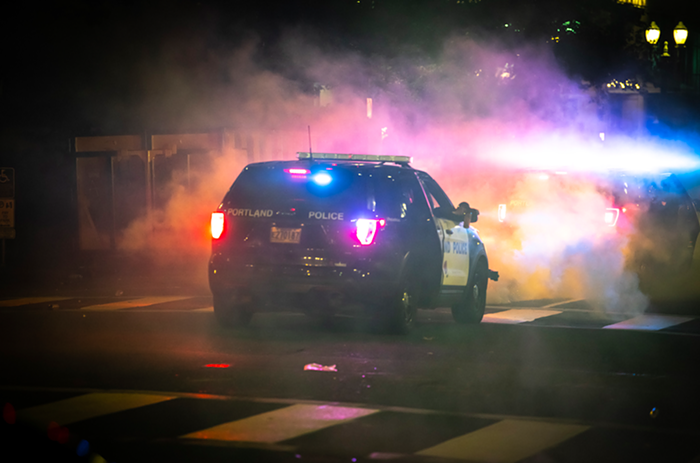“I was a daughter," Fanny Ball's oration begins, "I was born. I was the daughter of one of those chiefs, the ones that don’t die of old age. Kientpaush was hanged."
Kintpuash, Ball's father, was also called Captain Jack. He was a Modoc leader who resisted militarized white settlers in defense of Modoc lands, now known as Northern California and Oregon.
"Kientpaush was hanged. He was hunted, and imprisoned. He was judged, and he was hanged. His wife and youngest daughter were removed from Oregon, with the rest of the Modocs after the war.”
The reedy voice speaking is not a direct recording of Ball, but a performance by Angie Morrill—an artist and member of Super Futures Haunt Qollective (SFHQ). Morrill embodies Ball, performing as an avatar, providing a gleam of alternate history to the remnants of Indigenous existence in the Pacific Northwest.
Titled Visitation: From Chiloquin to Seattle via the Specularity, the audio project imagines a ghostly dialogue between Ball and Princess Angeline, who was also known as Kikisoblu, the daughter of Duwamish leader Chief Seattle.
SFHQ see it as their mission to disrupt and disassemble the historical narratives we commonly accept of land, colonialism, and power. “We are an interdisciplinary arts and research collective,” says Sam Jung, one of the three members. Morril—also a member—continues, “We use specularities, spatial and temporal dimensions, which are utilized by our avatars where they can meet people through time and space.”
“Another way I like to speak about specularity is in terms of relationships," C. Ree, the third member of SFHQ’s trio, says. "Like the Underground Railroad, it's a space that is not a location or a door per say, but these relationships that make the space are always in flux, always changing."
“This pioneer homesteading white narrative is so offensive and we wanted to kind of fuck it up.”
Formed in 2014, the group says its members aligned their artistic vision while studying and working at University of California, San Diego. At the time, Ree was grappling with ideas of revenge and haunting—the artist and scholar had organized solo performance projects while moonlighting as the ghostly avatar: Agent O. Ree’s previous work laid ground for SFHQ to further weave specularities into artistic substance.
Since then, the collective has unveiled performances, site-specific installations, and digital media projects around the country—largely in the Pacific Northwest. Jung and Morrill gave presence to their own avatars, named SFAOW (Specularity: Fugitive-Alterity Or Whatever) and Lady HOW (Haunting or Whatever), respectively.
Agent O, SFAOW, and Lady HOW amplify snags and introduce frictions into histories otherwise predicated on erasure and dominance, like poltergeists in a white-wall museum.
For Morrill, who is Klamath, the act of haunting is deeply personal. “Haunting or whatever, haunting has been a part of daily life, my ancestors. I don’t feel like we are ever alone, with the violence of always living on Indian land but having that constantly erased,” she says.
Visitation: From Chiloquin to Seattle via the Specularity explores the ethereal imprints of Indigenous soul upon land. The audio recording references Chief Seattle’s speech, in response to Governor Isaac Stevens’ maneuver to buy Indigenous territory. “He said or might have said,” Morrill's voice recites, “the dead have power, and the white people will never be alone, because our ghosts love this land, and our love will haunt every piece of it.”
In 2021, SFHQ further broadened their concept of the spectral unruliness of Indigenous life upon land, by recognizing it could encompass other species. "[There's an] undeniable history of manifest destiny and US settler-colonialism that goes hand in hand with beaver trade,” Ree explains.
“This pioneer homesteading white narrative is so offensive and we wanted to kind of fuck it up,” Morrill adds.
The creation of a United States, of roadways and townships, came out of a strenuous war against an immense capillary network of rivers, streams, and swamps, dotted ubiquitously with massive dams and their bumbling inhabitants. While the beaver fur trade is a well-known aspect of settler-colonial history, the uncategorizable nature of beavers is what SFHQ’s 2021 project, Super Furs for the Super Futures 77: Beavereavement, calls into its curious form.
A simple, animated online zine, Super Furs was inspired by the group's initial research into a story about 76 beavers that the Idaho Fish and Game Department displaced—oddly and perhaps cruelly—via parachute.
The zine also contains a full-page collage dedicated to the South Korean singer Taeyang—best known as a member of BIGBANG—whose translated song lyrics on a previous page lament the loss of a love held too hard.
The timing suggests these pages are related to an unthinkable tragedy Morrill endured in the 2021 death of her 22-year-old son Leroy Xavier Wass-Morill. “My son was murdered,” Morrill says. “I sat on the couch and cried a lot. We were able to talk about it together and think about it together, and when one of us isn't able to fully show up, we are still able to midwife things through.”
Working in a meandering way through those feelings and towards future projects, the collective is currently exploring mysticism through a post-colonial lens. “Superstitions have always been very fascinating, very populist, people-oriented knowledge—gendered, discounted, and classed,” Ree says.
But, appropriately enough, nothing is solid about Haunt Qollective's plans. The group says they shift their focus and scope for projects often. “We had long conversations at the dining table about what we thought haunting was, what we thought specularity was,” Morrill says. “We redefine ourselves from time to time, but always come back to love and social justice.”













